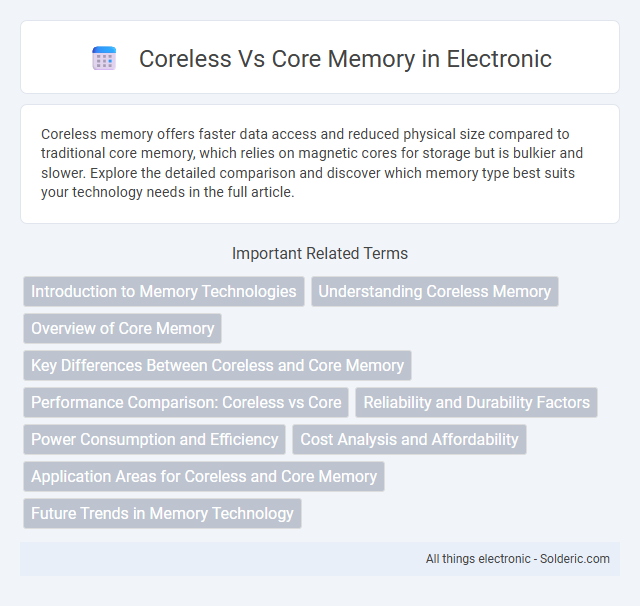Coreless memory offers faster data access and reduced physical size compared to traditional core memory, which relies on magnetic cores for storage but is bulkier and slower. Explore the detailed comparison and discover which memory type best suits your technology needs in the full article.
Comparison Table
| Feature | Coreless Memory | Core Memory |
|---|---|---|
| Technology Type | Semiconductor-based memory | Magnetic core-based memory |
| Storage Mechanism | Electric charge in transistors | Magnetic polarization of cores |
| Speed | High-speed data access | Slower compared to semiconductor memory |
| Reliability | Less affected by magnetic interference | Highly reliable, non-volatile |
| Power Consumption | Low power consumption | Higher power consumption |
| Data Volatility | Volatile memory (loses data when powered off) | Non-volatile memory (retains data without power) |
| Physical Size | Compact and lightweight | Bulkier due to magnetic cores |
| Usage Era | Modern computing systems | Used primarily in 1950s-1970s |
| Cost | Cost-effective for mass production | Expensive to manufacture |
Introduction to Memory Technologies
Core memory uses tiny magnetic cores to store data by magnetizing the cores in different directions, forming the basis for early computer memory technology with non-volatile characteristics. Coreless memory, in contrast, relies on semiconductor-based technologies such as DRAM or SRAM, which utilize transistors and capacitors to store bits with faster access speeds but volatility requiring constant power. The transition from core to coreless memory marked a significant shift toward more compact, efficient, and scalable electronic memory solutions in computing history.
Understanding Coreless Memory
Coreless memory refers to semiconductor-based storage systems that do not rely on magnetic cores, offering faster access speeds and greater scalability compared to traditional core memory. Understanding coreless memory involves recognizing its use of integrated circuits and solid-state technology to enhance performance and durability in modern computing devices. Your choice between coreless and core memory depends on the specific requirements for speed, capacity, and technological compatibility.
Overview of Core Memory
Core memory, developed in the mid-20th century, was a revolutionary form of non-volatile computer memory based on magnetic cores made from ferrite rings. It stored information by magnetizing tiny cores in different directions to represent binary data, offering fast access times and reliability compared to earlier memory technologies. Core memory's physical robustness and ability to retain data without power made it a foundational technology for early computers and aerospace applications.
Key Differences Between Coreless and Core Memory
Coreless memory utilizes modern semiconductor technology for faster access speeds, lower power consumption, and higher storage density compared to traditional core memory, which relies on magnetic cores for data storage. Core memory, an early form of non-volatile memory, offers durability and data retention without power but suffers from larger physical size and slower performance. Understanding these key differences helps you choose the appropriate memory type for applications requiring speed, efficiency, or reliability.
Performance Comparison: Coreless vs Core
Coreless memory typically offers faster access speeds due to the absence of magnetic cores, reducing latency and improving overall system performance. Core memory relies on magnetic cores, which introduces slower cycle times and higher power consumption compared to coreless alternatives. Advances in semiconductor technology have made coreless memory a more efficient choice for high-speed computing applications.
Reliability and Durability Factors
Coreless memory relies on semiconductor technology, offering faster speeds but potentially lower reliability due to susceptibility to electrical interference and wear from repeated write cycles. Core memory uses magnetic cores, known for exceptional durability and data retention even without power, which makes it highly reliable in harsh environments. The physical robustness of core memory contributes to its long lifespan, while coreless memory demands error correction methods to enhance stability over time.
Power Consumption and Efficiency
Coreless memory architectures significantly reduce power consumption by eliminating magnetic cores, which require constant current to maintain data states. Core memory relies on sustained electric currents through ferrite cores, leading to higher energy usage and generating more heat during operation. The improved efficiency of coreless memory supports energy-saving initiatives in modern computing environments by optimizing voltage utilization and minimizing continuous power draw.
Cost Analysis and Affordability
Coreless memory technology typically offers lower production costs due to the absence of magnetic cores, reducing material expenses and simplifying manufacturing processes. Core memory, while historically reliable, involves higher costs from the use of ferrite cores and labor-intensive assembly methods, impacting affordability in large-scale applications. For budget-sensitive projects, coreless memory solutions provide a cost-effective alternative without significantly compromising performance.
Application Areas for Coreless and Core Memory
Coreless memory is commonly used in modern computing devices where high-speed, low-latency data access is critical, such as in CPUs and GPUs for cache storage and embedded systems. Core memory finds application primarily in legacy systems and vintage computing where magnetic core technology is utilized for non-volatile storage, often in aerospace and military equipment due to its durability and radiation resistance. Your choice between coreless and core memory depends on the need for speed, durability, and the specific operational environment of the device.
Future Trends in Memory Technology
Emerging memory technologies are shifting from traditional coreless designs toward advanced core memory alternatives that offer increased density, speed, and energy efficiency. Innovations such as magnetoresistive RAM (MRAM) and phase-change memory (PCM) are rapidly gaining traction as core memory evolves to meet the demands of AI, IoT, and big data applications. Your future devices will likely benefit from these breakthroughs, providing faster access times, enhanced durability, and reduced power consumption.
Coreless vs Core Memory Infographic

 solderic.com
solderic.com